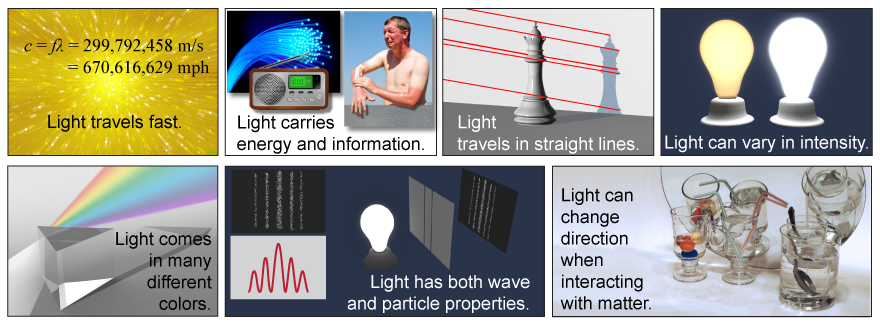|
Virtually all people and animals see the world through light. Televisions, candles flames, light bulbs, and the Sun emit light. Trees, cars, people, the sky, and almost everything else reflect light. In either case, “seeing” is the reception and interpretation of the energy in light by the eye and brain. How objects emit light was not understood until the early 20th century and is discussed in Chapter 26. How light is reflected, refracted, and dispersed were all understood (to some extent) since the time of Galileo. 
|
Seven properties of light
|

|
Light travels faster than anything else, moving 300 million meters per second (3×108 m/s). This is fast enough to circle the Earth 7.5 times in one second. It takes just over eight minutes for light to travel 150 million kilometers from the Sun to the Earth. 
|
Light carries radiant energy and information. A lizard warms itself in the sun by absorbing energy from sunlight. Optical fibers use light to transmit information or communicate. Internet traffic and telephone calls travel through optical fiber cables. 
|
When unimpeded by matter or objects, light travels in straight lines. This is the explanation for why shadows form. 
|
Light can vary in intensity. The difference between dim and bright light bulbs is an example. The energy of light depends on both its intensity and its frequency. 
|
White light can be dispersed by a prism into the rainbow of colors. Light is also called electromagnetic radiation, a more general term spanning a broader spectrum of “colors” that includes x-rays, ultraviolet light, infrared radiation, and radio waves. 
|
For many applications light behaves as a wave, having frequency, wavelength, phase, and polarization. In the quantum world, however, light also acts like a particle called a photon. A photon is a tiny, discrete bundle of light energy. 
|
When light interacts with matter its direction can be changed. Light is reflected by mirrors, refracted by glass or water, or diffracted when passing through a narrow slit. Microscopes, telescopes, and the eye use optics to focus light and form images. 
|
Which of the following is not a property of light? - Light travels slowly.
- Light varies in intensity.
- Light carries energy.
- Light exhibits wave properties.
 |
The correct answer is a. Light travels faster than anything else. 
|

